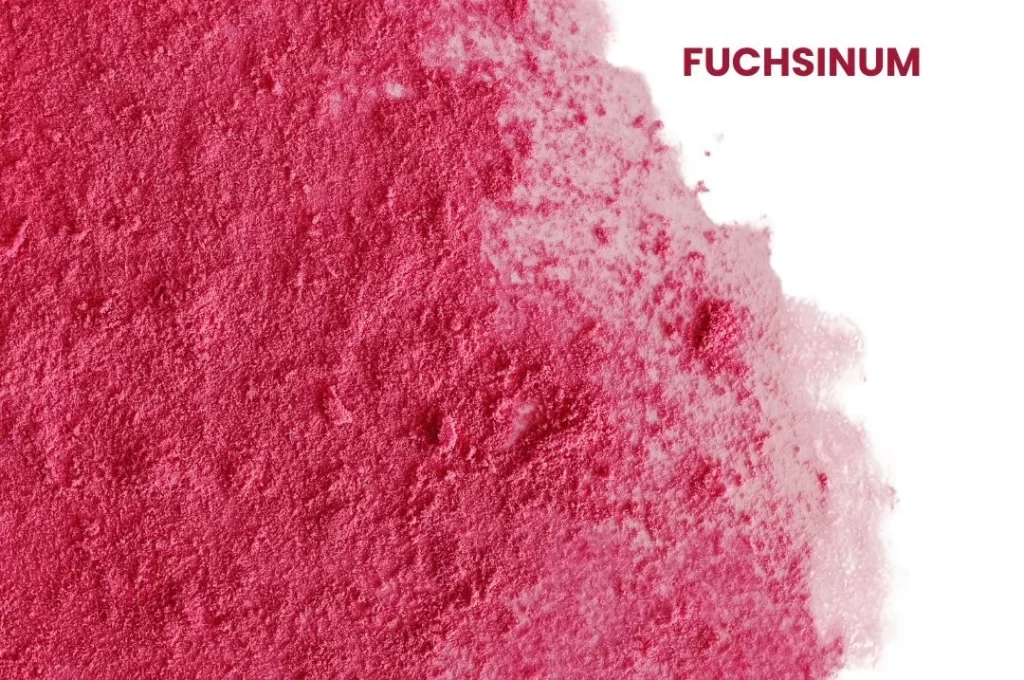Fuchsinum, also known as Fuchsina or Magenta, is a synthetic dye that has historically been used in various industrial applications, including the adulteration of wine.
In homeopathy, it is known for its distinctive ability to produce and treat symptoms related to redness, inflammation, and nephritis.

SOURCE INFORMATION
Scientific Classification
- Kingdom: Synthetic compound
- Category: Dye
- Chemical Formula: C₂0H₂0N₃Cl
Origin
- Fuchsina is a synthetic dye discovered in the 19th century and named after the German botanist Leonhart Fuchs.
- It is commonly used as a biological stain and was infamously used to adulterate wine due to its vibrant magenta colour.
Historical Facts
- Originally developed for industrial purposes, Fuchsinum’s toxicological effects on the human body were later studied, leading to its homeopathic applications.
- The recognition of its impact on various organ systems, particularly the kidneys, has made it a remedy of interest in homeopathy.
DRUG PATHOGENESIS
- Fuchsinum acts on the body by affecting the mucous membranes, urinary system, and gastrointestinal tract.
- It is known to produce symptoms such as redness and inflammation in the mouth, swelling of gums, red discoloration of urine, and abdominal pain with diarrhea.
KEY CHARACTERISTICS
- Redness and inflammation: Notable for causing redness in various parts of the body, particularly the ears and mouth.
- Urinary symptoms: Produces deep red, albuminous urine, indicative of kidney involvement.
- Gastrointestinal distress: Characterized by profuse, light red diarrhea and abdominal pain.
DETAILED ORGAN SYMPTOMS
MOUTH
- Redness and swelling: The mouth and gums become deeply red and swollen.
- Burning sensation: A persistent burning feeling in the mouth.
- Salivation: Increased production of saliva, often with a burning sensation.
EARS
- Redness: The ears appear markedly red, often associated with heat and discomfort.
URINARY SYSTEM
- Red urine: Urine appears deep red, often with albumin (a protein) present.
- Cortical nephritis: Inflammation and degeneration of the cortical substance of the kidneys, leading to albuminuria (protein in the urine).
GASTROINTESTINAL SYSTEM
- Diarrhea: Profuse, light red diarrhea accompanied by abdominal pain.
- Abdominal pain: Pain and discomfort in the abdominal area, often severe.
MODALITIES
- Aggravations: Symptoms may worsen with exposure to the dye or similar irritants.
- Ameliorations: Relief is often seen with the cessation of exposure to the offending substance and appropriate homeopathic treatment.
WHAT ARE MODALITIES IN HOMOEOPATHY?
RELATIONSHIP WITH OTHER DRUGS
- Compare with: Other homeopathic remedies for nephritis and gastrointestinal disturbances, such as Cantharis and Arsenicum album.
DOSE
- Typically administered in potencies ranging from 6x to 30th potency, depending on the specific symptoms and patient’s response.
Frequently Asked Questions
What conditions does Fuchsinum treat?
- It is primarily used for symptoms involving redness and inflammation of the mouth and ears, urinary issues such as albuminous urine, and gastrointestinal disturbances including profuse diarrhea and abdominal pain.
How should Fuchsinum be dosed?
- The remedy is usually prescribed in the 6x to 30th potency, based on the individual’s specific symptoms and their intensity.
Meaning of Difficult Words
- Albuminous: Containing or resembling albumin, a type of protein found in the blood and urine.
- Nephritis: Inflammation of the kidneys.
- Cortical substance: The outer part of an organ, especially the kidneys.
- Salivation: Excessive production of saliva.
- Mucous membranes: The moist lining of some organs and body cavities, such as the nose, mouth, and lungs.
- Diarrhea: Frequent, loose, or watery bowel movements.
- Albuminuria: The presence of albumin in the urine, typically a sign of kidney disease.
This comprehensive drug picture of Fuchsinum provides a detailed overview of its homeopathic uses, source information, specific symptoms across different organ systems, and its application in homeopathic practice.
